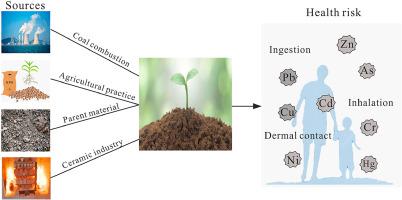Environmental Pollution ( IF 8.9 ) Pub Date : 2020-09-23 , DOI: 10.1016/j.envpol.2020.115699 Xuefei Sun , Lixia Zhang , Jianshu Lv

|
Quantifying source apportionment of potentially toxic elements (PTEs) in soils and associated human health risk (HHR) is essential for soil environment regulation and pollution risk mitigation. For this purpose, an integrated method was proposed, and applied to a dataset consisting of As, Cd, Cr, Cu, Hg, Ni, Pb, Se, and Zn in 273 soil surface samples. Positive matrix factorization (PMF) was used to quantitatively examine sources contributions of PTEs in soils; and the HHR arising from the identified source was determined by combining source profiles and health risk assessment; at last, sequential Gaussian simulation (SGS) was used to identify the areas with high HHR. Four sources were identified by PMF. Natural and agricultural sources affected all 9 PTEs contents with contributions ranging from 19.2% to 62.9%. 41.9% of Cd, 40.8% of Pb, 58.6% of Se, and 29.8% of Zn were controlled by industrial and traffic emissions. Metals smelting and mining explained 35.5%, 30.5%, and 24.9% of Cr, Cu, and Ni variations, respectively. Hg was dominated by atmospheric deposition from coal combustion and coking (58.7%). The mean values of the total non-carcinogenic risks of PTEs were 1.55 × 10−1 and 9.40 × 10−1 for adults and children, and the total carcinogenic risk of PTEs had an average value of 8.86 × 10−5. Based on source-oriented HHR calculation, natural and agricultural sources were the most important factor influencing HHR, explaining 51.0% and 49.1% of non-carcinogenic risks for children and adults, and 44.2% of carcinogenic risk. SGS indicated that 1.1% of the total area was identified as hazardous areas with non-carcinogens risk for children.
中文翻译:

空间评估模型,用于评估与土壤潜在有毒元素相关的人类健康风险
量化土壤中潜在毒性元素(PTE)的来源分配以及相关的人类健康风险(HHR)对于土壤环境监管和减轻污染风险至关重要。为此,提出了一种综合方法,并将其应用于273个土壤表面样品中的由As,Cd,Cr,Cu,Hg,Ni,Pb,Se和Zn组成的数据集。正矩阵分解(PMF)用于定量检查土壤中PTE的来源贡献;通过将来源概况和健康风险评估相结合,确定来自确定来源的HHR;最后,采用顺序高斯模拟(SGS)来识别具有较高HHR的区域。PMF确定了四个来源。自然和农业资源影响了全部9个PTE的含量,贡献率从19.2%到62.9%。镉41.9%,铅40.8%,58。工业和交通排放控制了6%的Se和Zn的29.8%。金属冶炼和采矿分别解释了35.5%,30.5%和24.9%的Cr,Cu和Ni变化。汞主要来自煤燃烧和焦化的大气沉积(58.7%)。PTE的总非致癌风险平均值为1.55×10成人和儿童的-1和9.40×10 -1,PTE的总致癌风险平均值为8.86×10 -5。根据以源为单位的HHR计算,自然和农业来源是影响HHR的最重要因素,解释了51.0%和49.1%的儿童和成人非致癌风险以及44.2%的致癌风险。SGS指出,总面积的1.1%被确定为儿童非致癌物风险的危险区域。


























 京公网安备 11010802027423号
京公网安备 11010802027423号